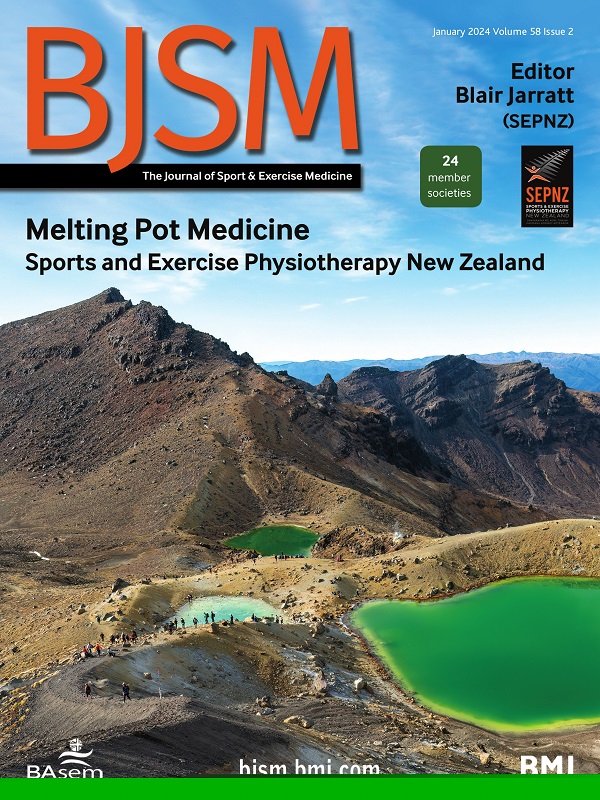Bringing reproductive, pelvic and breast health to light: insights from the Health of Elite Retired Australian female athletes survey (HER-Aus)
IF 11.6
1区 医学
Q1 SPORT SCIENCES
引用次数: 0
Abstract
Objectives To describe the reproductive, pelvic and breast health of retired elite Australian female athletes. Methods Data were collected as part of a larger online cross-sectional survey that was cocreated with female athletes and disseminated to Australian retired elite (international-level and national-level) female athletes aged ≥18 years old and retired from elite competition ≥2 years. Results 199 retired female athletes (mean (SD) age 44 (10) years; retired for 16 (9) years; competed for 10 (5) years) across 31 different sports responded to the survey. 23% (46/199) experienced primary amenorrhoea, and 48% (95/197) reported ever experiencing secondary amenorrhoea. Of athletes with pregnancy difficulties (n=45), 42% reported menstrual cycle irregularity during their career. Of athletes who gave birth (n=98), 19% had difficulties conceiving, requiring fertility treatments. The majority of athletes reported current symptoms of urinary incontinence (70% (140/198)) and faecal incontinence (54% (106/197)). 18% (33/188) reported that they currently experience exercise-related breast pain; however, 87% (164/188) reported that breast pain never negatively impacts their current physical activity. Conclusions A high prevalence of reported menstrual irregularities, pelvic floor dysfunction and fertility issues highlights the need for early prevention and intervention measures to address long-term health and the unique challenges faced by female athletes during and after their sporting careers. Data are available on reasonable request.让生殖、骨盆和乳房健康浮出水面:来自澳大利亚优秀退役女运动员健康调查(HER-Aus)的见解
目的了解澳大利亚退役优秀女运动员的生殖、骨盆和乳房健康状况。方法数据收集作为与女运动员共同创建的更大的在线横断面调查的一部分,并传播给年龄≥18岁且从精英比赛中退役≥2年的澳大利亚退役精英(国际级和国家级)女运动员。结果退役女运动员199例,平均(SD)年龄44(10)岁;退休16(9)年;参加了10(5)年的31项不同的运动。23%(46/199)的患者经历过原发性闭经,48%(95/197)的患者报告曾经历过继发性闭经。在有妊娠困难的运动员中(n=45), 42%的运动员在其职业生涯中报告月经周期不规律。在分娩的运动员中(n=98), 19%有受孕困难,需要生育治疗。大多数运动员报告目前的症状为尿失禁(70%(140/198))和大便失禁(54%(106/197))。18%(33/188)的人报告说,他们目前经历与运动有关的乳房疼痛;然而,87%(164/188)的人报告乳房疼痛从未对他们目前的体育活动产生负面影响。结论月经不调、盆底功能障碍和生育问题的高发生率突出了早期预防和干预措施的必要性,以解决长期健康问题,以及女性运动员在运动生涯中和运动生涯后面临的独特挑战。如有合理要求,可提供资料。
本文章由计算机程序翻译,如有差异,请以英文原文为准。
求助全文
约1分钟内获得全文
求助全文
来源期刊
CiteScore
27.10
自引率
4.90%
发文量
217
审稿时长
3-8 weeks
期刊介绍:
The British Journal of Sports Medicine (BJSM) is a dynamic platform that presents groundbreaking research, thought-provoking reviews, and meaningful discussions on sport and exercise medicine. Our focus encompasses various clinically-relevant aspects such as physiotherapy, physical therapy, and rehabilitation. With an aim to foster innovation, education, and knowledge translation, we strive to bridge the gap between research and practical implementation in the field. Our multi-media approach, including web, print, video, and audio resources, along with our active presence on social media, connects a global community of healthcare professionals dedicated to treating active individuals.

 求助内容:
求助内容: 应助结果提醒方式:
应助结果提醒方式:


